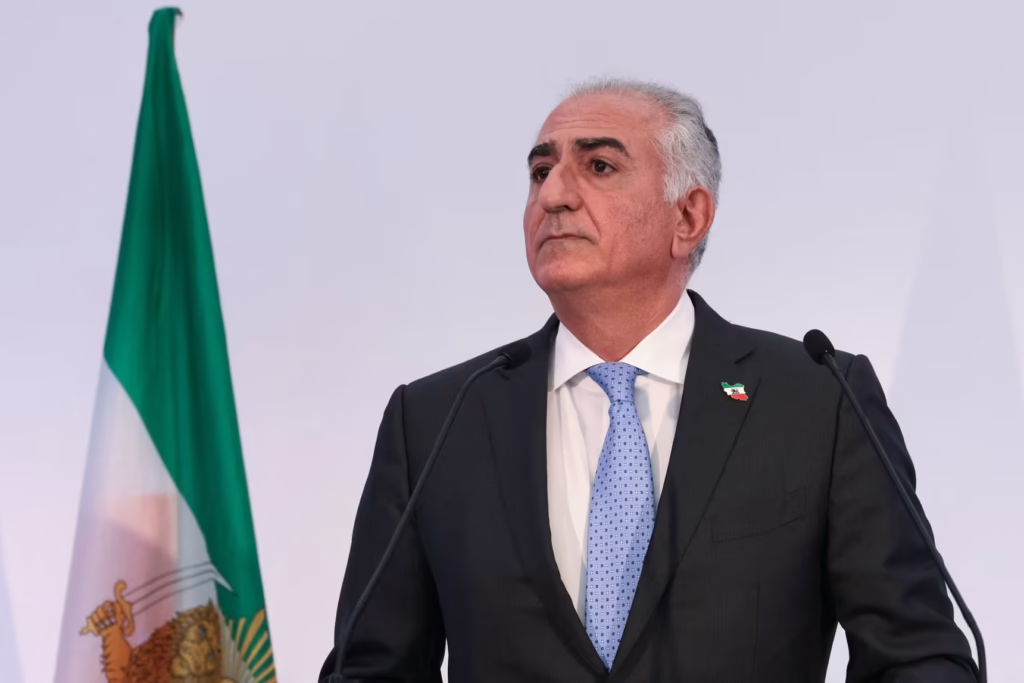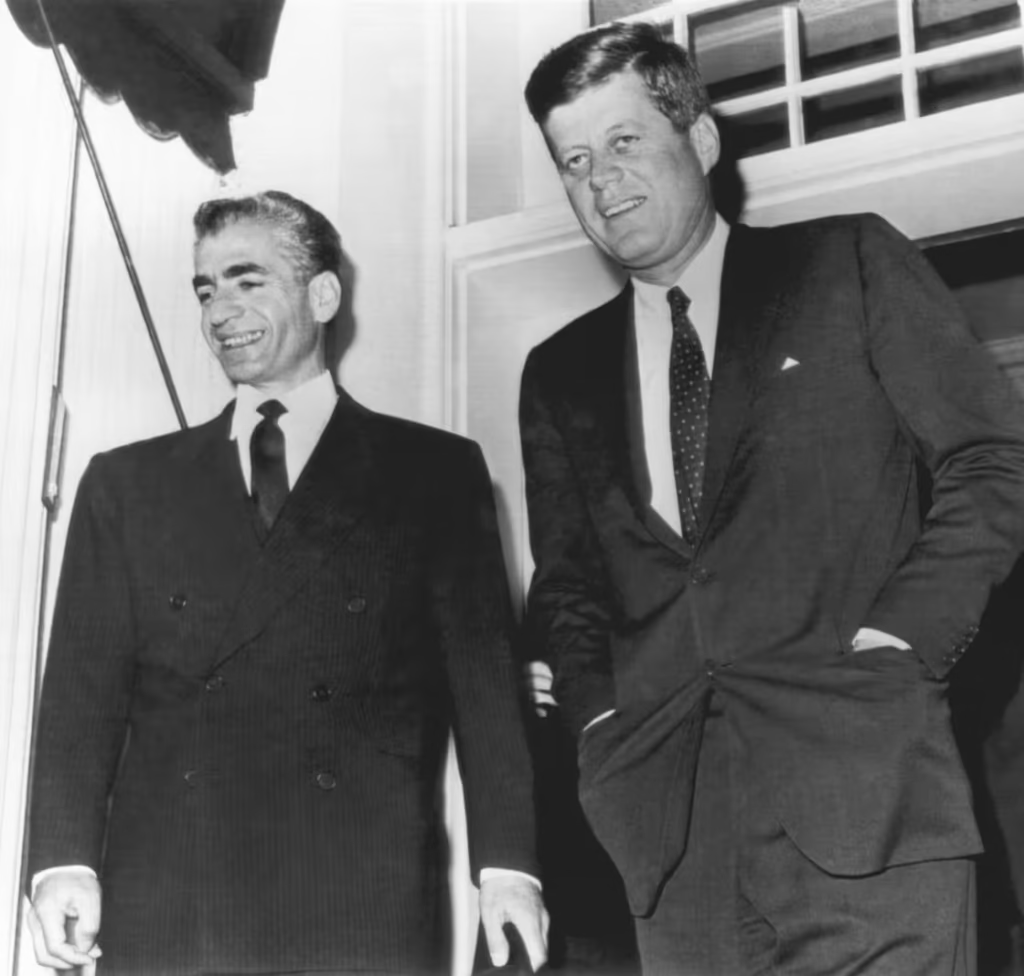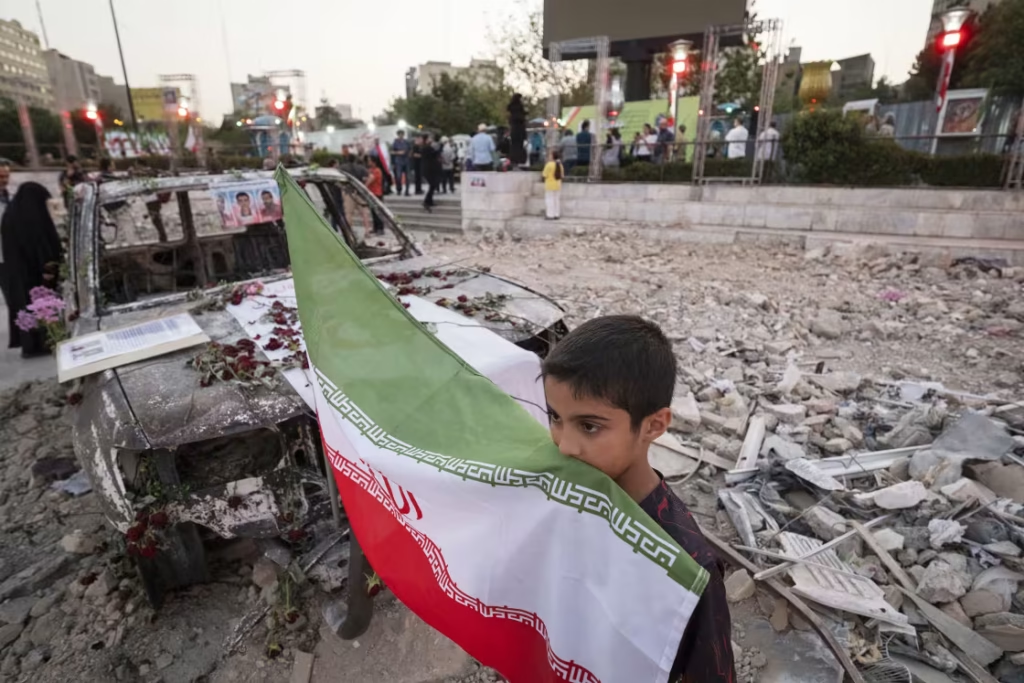Reza Pahlavi, whose father was deposed in the 1979 Islamic Revolution, is Iran’s most recognizable opposition figure.

Reza Pahlavi in Paris on Monday.
In a Q&A session that drew from a list of preselected journalists, rather than from raised hands in the room, he reiterated his “core principles” for a new Iran: individual liberties, equality of “all citizens” and the separation of religion and state.
Pahlavi, 64, is son of the country’s former shah, Mohammad Reza Pahlavi, whose decadeslong autocratic rule was bolstered by a CIA-backed coup in 1953.
The pro-Western shah oversaw what’s widely considered an economic “golden age” — with yearly growth above 10% from 1965 to 1972. But he also lived lavishly, seizing increasing power while relying on the ruthless SAVAK secret police, which sowed deep anger and fear among his subjects. This culminated in the Islamic Revolution of 1979 with the shah and his family fleeing to the U.S. and Ayatollah Ruhollah Khomeini returning from exile and taking power.
Prince Pahlavi had left the country a year before his father was overthrown, and started training to be a jet fighter pilot at Reese Air Force Base in Lubbock, Texas. He never returned.
Today he remains the most recognizable Iranian opposition figure, dressed here in a light-blue tie and thick-rimmed spectacles that emphasize bushy, black eyebrows. But his family’s history, and his support for the Israeli airstrikes against his own homeland, mean he is divisive, both among Iran’s diaspora and its domestic population of 90 million
“His main strength is a nostalgia for the prerevolutionary time, not just among the old people of Iran, but also among Gen Z, who have this image of a secular Iran,” said Clément Therme, an Iran scholar with affiliations at Paris’ Sciences Po university and the French Institute of International Relations, among others.

President John F. Kennedy with the Shah of Iran Mohammad Reza Pahlavi at the White House in 1962.
But while Pahlavi has become a talisman for many in the diaspora, he has had “limited contact” with opposition groups inside the country, Therme said. “So it will be difficult for him to represent” them.
Nevertheless, his backers sense an opportunity.
Though the U.S. denies regime change is an official war goal, Trump’s call to “MAKE IRAN GREAT AGAIN” saw Pahlavi’s supporters respond with memes and artificial intelligence-generated images of “MIGA” baseball caps.
This worldwide profile makes Pahlavi a target, these supporters believe, for an Iranian regime that the State Department says and human rights groups say has been responsible for hundreds of political assassinations over the decades. In a sign that Pahlavi and his retinue take the regime threat seriously, on Monday French police made all journalists arrive an hour early and leave their bags in a courtyard for 10 minutes for investigation by a sniffer dog.
Inside, Pahlavi described this as Iran’s “Berlin Wall moment,” claiming that Supreme Leader Ayatollah Ali Khamenei was “teetering on the edge of collapse” and that his family was “making preparations to flee.”
After Israeli forces killed a slew of military leaders and nuclear scientists, Khamenei has been hiding in a bunker, with the three-man committee responsible for naming his successor accelerating its plans in recent days, anonymous sources told Reuters. The strikes were not as effective as Trump said, however, setting back the country’s nuclear program by three-to-six months, according to three people with knowledge of an initial Defense Intelligence Agency assessment.
In Paris, Pahlavi told Western countries not to “continue to appease this regime,” which he said would “not submit or surrender after it has been humiliated: It will lash out.”
He added: “We stand at a crossroads: One road leads to bloodshed and chaos. The other — to a peaceful and democratic transition.”

Supporters of regime change in Iran rally in Los Angeles on Monday.
This rallying cry is alluring for many of the 4 million Iranian exiles and expats worldwide, just under a third of whom live in the U.S., according to Iranian Foreign Ministry statistics from 2021.
“If change does come, the only path that offers both stability and a sense of national continuity is through Pahlavi,” said Amin, 38, an Iranian now living in Canada who declined to give his second name or exact location because of fear of speaking out against the regime even from abroad.
There is a disagreement among experts about Pahlavi’s popularity inside Iran itself.
A 2022 study by Gamaan, a Dutch-based research group, gauged Pahlavi’s domestic popularity at 39%, far more than then-Prime Minister Ebrahim Raisi, in second with 17%, and imprisoned Nobel Peace laureate Narges Mohammadi on 15%.
“He is the only national figure inside Iran with cross-generational, cross-class, and cross-ethnic legitimacy,” one prominent Iranian diaspora account on X, @upuouo, said last week.
Other contenders abroad include the dissident group Mujahedeen e-Khalq, more commonly known as the MEK, which has gained high-profile supporters including the former New York mayor and Trump ally Rudy Giuliani. But MEK, widely seen by Western experts as a cult, has negligible support inside Iran thanks to its backing for Saddam Hussein during the Iran-Iraq war of 1980-88.
Critics of Pahlavi see him as the pro-Western figurehead of a dynasty that took power in the 1920s aided by the British, cemented its grip with help from the CIA, and is only poised for a return following airstrikes by Israel and the U.S.
Amin Aghdasi, 30, from Tehran, described him as “a coward who betrays his nation” and someone waiting “for power to be handed to him.” Pahlavi “thinks a war criminal like Bibi can help bring back his monarchy,” Aghdasi added, referring to Israeli Prime Minister Benjamin Netanyahu.
NBC News has requested comment from Pahlavi’s media team, both on concerns about his familial ties to his father’s legacy, and the decision to use preselected questions at his news conference.

A young Iranian boy holds the national flag next to a destroyed ambulance in Tehran on Monday.
Some analysts are also skeptical of polling inside Iran, where some opinions can lead to jail or worse.
“There’s been a real push to get Pahlavi to be seen as a credible opposition figure in Iran, but my sense is he’s not,” said Dina Esfandiary, the Middle East geoeconomics lead for Bloomberg Economics, Bloomberg’s internal research division. “He’s got a following outside of the country,” but “honestly, inside Iran, not that much. He hasn’t been inside the country in over 40 years” and many “people believe his family is the reason why Iran is where it is today.”
She agrees there are few good options.
“That’s one of the reasons why the Iranian people, while they want change, are afraid of it, because they have nobody to coalesce around,” she said. Any lasting solution, she thinks, would “need Iranians to work together and to present a viable opposition.”
One reason that’s not been possible domestically is Iran’s crushing of successive protest movements with deadly force. Most notably the Green Movement of 2009, in which marchers railed against that year’s rigged election, and the mass outcry over the death of Mahsa Amini following her detention for not following female headscarf laws in 2022.
In Paris, Pahlavi sought to portray himself as a model of openness and selflessness who would help birth a new peaceful and democratic era in Iran, perhaps along the lines of Spain’s King Juan Carlos I who helped dismantle the authoritarian regime of Francisco Franco and establish a parliamentary monarchy.
Though he was reluctant to give a formal name to the transitional role he might play — saying “I don’t believe I need a title” — he was unequivocal about his message to the ayatollah.
“Step down,” he said down the barrel of the camera. “If you do, you will receive a fair trial and due process of law — which is more than you have ever given any Iranian.”


